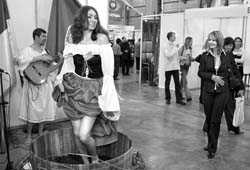Learn to Drink Wine!
The 3rd International Wine Festival has ended
Every year, on the third Thursday in November, the world traditionally tastes young wines. For a long time Ukraine had no such festival. Today, however, the situation has changed, and for the third year in a row a festival dedicated to young wines has been held in our country. During the Third International Festival of Wine and Professional Skill “Vinofest-2004,” wines were tasted by experts and visitors alike in a joyous ceremony, which included girls dancing in vats filled with grapes and long lines waiting to enter the wine-tasting tents.
The year 2004 was not the best for making wine. V. Mosynevych, Director General of the Ukrvynprom Corporation, says that 100,000 fewer tons of grapes were processed this year than in 2003. The reason is simple: bad weather. Even though a number of vineyards had good yields, the overall situation showed that most winemakers were totally unprepared for the adverse weather conditions. This, in turn, will affect prices, as the cost of grapes rose considerably, owing to the energy spent on saving the harvest. Will this also affect wine quality? According to Mr. Mosynevych, this year’s wines will have certain characteristics, “But I can’t say that they will be worse than last year’s. We’ve just tasted several types of young wine, including a Cabernet, which is very good and can be stored for maturation and then offered to the most demanding consumers.”
Experts, however, insist that Ukrainian wines and vineyards have great potential, and that Ukrainian wines have made their names throughout the world. Recently, wine samples were again selected at the Crimean-based Massandra Winery for presentation at Sotheby’s, where a bottle sells at no less than $10,000. Another source of Ukrainian pride is cognac, the peak of the winemaking art, something few other wine-producing countries can boast about.
Viniculture is supposed to foster a wine-drinking culture. The fact remains that 30,000 cases of alcoholic intoxication are recorded annually in Ukraine. Of course, this does not indicate the presence of an advanced wine-drinking culture. In other words, Ukrainians haven’t learned to distinguish between alcoholic beverages suitable for consumption and those that are not. Experts believe there is no way to re-educate fake wine producers, because the profits are too good and the law is too soft, so the only way is to re-educate the consumer. Re- education then is one of the festival’s tasks. Natalia Blahopoluchna, festival organizer and President of the All-Ukraine Winemakers and Sommeliers Association, says that the slow progress of the wine-consuming culture in Ukraine is primarily explained by mentality; historically, over the past several centuries Ukrainians have consumed stronger drinks while the rest of the world has been enjoying good wines.
The sommelier is an important part of viniculture. These people are trained to recommend wines discreetly and elegantly to diners, which will best enhance their food orders and conform to their mood. The jury of the festival’s sommelier contest noted that Ukrainians are becoming gradually convinced that food is washed down with wine, not the other way around. In other words, drinking wine is an aesthetic activity, so the average person will find it very difficult to select the kind of wine best suited to the occasion. Sommeliers are on the payroll of most Kyiv restaurants and even in some of the regions. Four years ago, when a sommelier school was opened in Ukraine, few people even knew the meaning of the word, restaurant managers included. “Funny things used to happen. When I introduced myself and said I was a sommelier, people thought it had something to do with the family, and on one occasion I was asked what a Somalian school was doing in Ukraine,” recalls Natalia Blahopoluchna.
What wines do Ukrainians prefer? Semi-dry and semi-sweet brands appear to be the most popular. White wines are also in great demand, perhaps because a person can drink more white wine than red. White wines are also served with a variety of foods. Starting in 2000, there has been a steady increase in the output of wines, cognacs, and champagnes. The process has been largely helped by a stable taxation base. In the last year and a half tax rates have been changing at a feverish pace. Last week, a law was enacted, compelling Ukrainian winemakers to pay the state 50 kopiykas for every liter of fortified wine and 25 kopiykas for a liter of dry, semi- dry, or vintage wine. “That’s a tax increase, but it’s not excessive and we’ll survive,” notes V. Mosynevych. However, a similar law was adopted in June of this year, which the president eventually vetoed, so winemakers are not ruling out the possibility of the same outcome this time.






